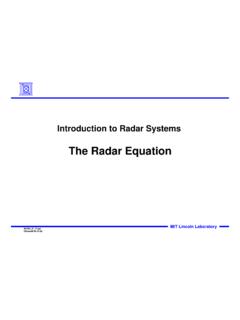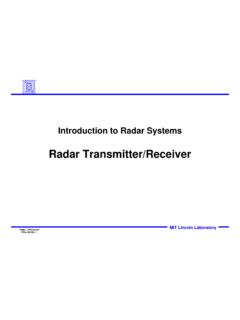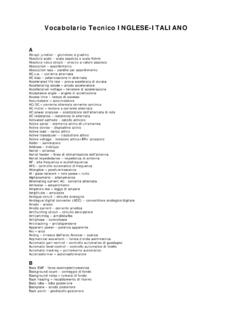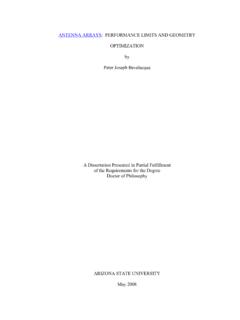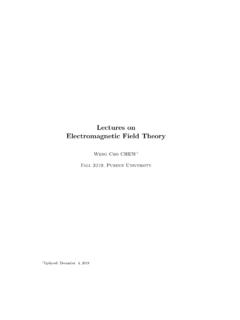Transcription of Introduction to Radar Systems 2002 Introduction
1 Introduction -1AG 6/18/02 MIT Lincoln LaboratoryIntroduction to Radar Systems Dr. Robert M. O DonnellMIT Lincoln LaboratoryIntroduction-2AG 6/18/02 Disclaimer of Endorsement and Liability The video courseware and accompanying viewgraphs presented on this server were prepared as an account of work sponsored by an agency of the United States Government. Neither the United States Government nor any agency thereof, nor any of their employees, nor the Massachusetts Institute of Technology and its Lincoln Laboratory, nor any of their contractors, subcontractors, or their employees, makes any warranty, express or implied, or assumes any legal liability or responsibility for the accuracy, completeness, or usefulness of any information, apparatus, products, or process disclosed, or represents that its use would not infringe privately owned rights. Reference herein to any specific commercial product, process, or service by trade name, trademark, manufacturer, or otherwise does not necessarily constitute or imply its endorsement, recommendation, or favoring by the United States Government, any agency thereof, or any of their contractors or subcontractors or the Massachusetts Institute of Technology and its Lincoln Laboratory.
2 The views and opinions expressed herein do not necessarily state or reflect those of the United States Government or any agency thereof or any of their contractors or subcontractorsIntroduction-3AG 6/18/02 MIT Lincoln LaboratoryIntroduction to Radar Systems IntroductionMIT Lincoln LaboratoryIntroduction-4AG 6/18/02 Acknowledgement Developers of Tutorial Material Dr. Eric D. Evans Dr. Andrew D. Gerber Dr. Robert M. O Donnell Dr. Robert G. Atkins Dr. Pamela R. Evans Dr. Robert J. Galejs Dr. Jeffrey S. Herd Dr. Claude F. Noiseux Dr. Philip K. W. Phu Dr. Nicholas B. Pulsone Dr. Katherine A. Rink Dr. James Ward Dr. Stephen D. Weiner And many othersMIT Lincoln LaboratoryIntroduction-5AG 6/18/02 Background on the Course One of Many Radar Courses Presented at the Laboratory Relatively Short 10 lectures 40 to 60 minutes each Introductory in Scope Basic Radar Concepts Minimal Mathematical Formalism Prerequisite A College Degree Preferred in Engineering or Science, but not Required More Advanced Issues Dealt with in Other Laboratory Radar CoursesMIT Lincoln LaboratoryIntroduction-6AG 6/18/02 Outline Why Radar ?
3 The basics Course agendaMIT Lincoln LaboratoryIntroduction-7AG 6/18/02 What Means are Available for Lifting the Fog of War ?The Invasion of NormandyD-Day + 1D-Day Courtesy of National Lincoln LaboratoryIntroduction-8AG 6/18/02 What Means are Available for Lifting the Fog of War ?Iwo Jima1945 Courtesy of National of National of US Marine Corp, History Lincoln LaboratoryIntroduction-9AG 6/18/02 Military Means of Sensing Sonar Blast detection Troop movement detection Ground surveillance/ reconnaissance/ID Laser targeting Night vision Space surveillance Missile seekers Chem/Bio Radiological Surveillance Tracking Fire control Target ID/ discrimination Ground surveillance/ reconnaissance Ground mapping Moving target detection Air traffic control Missile seekersOptical/IR Radar Acoustic OtherApplicationsAttributes Long range All-weather Day/night 3-space target location Reasonably robust against countermeasuresMIT Lincoln LaboratoryIntroduction-10AG 6/18/02 Early Days of Radar Chain Home Radar , Deployment Began 1936 Chain Home Radar Coveragecirca 1940(21 Early Warning Radar Sites)
4 Sept 2006 Photograph of Three Chain Home Transmit Towers, near DoverCourtesy of Robert with SiteMIT Lincoln LaboratoryIntroduction-11AG 6/18/02 Chain Home Radar System Frequency 20-30 MHz Wavelength 10-15 m antenna Dipole array on Transmit Crossed dipoles on Receive Azimuth Beamwidth About 100o Peak Power 350 kW Detection Range ~160 nmi on German BomberRadar ParametersTypical Chain Home Radar SiteMIT Lincoln LaboratoryIntroduction-12AG 6/18/02 Chain Home Transmit & Receive Antennas360'240'215'95'45'0' /2 /2 MainAntennaGap FillerAntennaTwo Transmitter TowersOne Receiver TowerTransmit AntennaReceive AntennaMIT Lincoln LaboratoryIntroduction-13AG 6/18/02 Radar and The Battle of Britain The Chain Home Radar British Force Multiplier during the Battle of Britain Timely warning of direction and size of German aircraft attacks allowed British to Focus their limited numbers of interceptor aircraft Achieve numerical parity with the attacking German aircraft Effect on the War
5 Germany was unable to achieve Air Superiority Invasion of Great Britain was postponed indefinitelyChain Home Radar Coveragecirca 1940(21 Early Warning Radar Sites)MIT Lincoln LaboratoryIntroduction-14AG 6/18/02 Surveillance and Fire Control RadarsCourtesy of Raytheon. Used with of Raytheon. Used with of Raytheon. Used with of with of with courtesy Photo courtesy of ITT of ITT with Used with of Global with of US Navy. MIT Lincoln LaboratoryIntroduction-15AG 6/18/02 Airborne and Air Traffic Control RadarsCourtesy Lincoln of Northrop of Northrop with with of Boeing Used with permissionCourtesy of US Navy. Courtesy of US Air of US Air Force. Courtesy of US Air of US Air Force. MIT Lincoln LaboratoryIntroduction-16AG 6/18/02 Instrumentation RadarsMIT Lincoln LaboratoryIntroduction-17AG 6/18/02 Outline Why Radar ? The basics Course agendaMIT Lincoln LaboratoryIntroduction-18AG 6/18/02 Radar RAdio Detection And RangingRadar observables: Target range Target angles (azimuth & elevation) Target size ( Radar cross section) Target speed (Doppler) Target features (imaging)AntennaTransmittedPulseTargetCr ossSection PropagationReflectedPulse( echo )MIT Lincoln LaboratoryIntroduction-19AG 6/18/02 Electromagnetic WavesRadar FrequenciesCourtesy Berkeley National LaboratoryMIT Lincoln LaboratoryIntroduction-20AG 6/18/02 Properties of Waves Relationship Between Frequency and WavelengthSpeed of light, cc = 3x108 m/sec= 300,000,000 m/sec Frequency (1/s) =Speed of light (m/s)Wavelength (m) Examples:Frequency Wavelength100 MHz 3 m1 GHz 30 cm3 GHz 10 cm10 GHz 3 cm1, 2, 3.
6 Figure by MIT Lincoln LaboratoryIntroduction-21AG 6/18/02 Properties of Waves Phase and AmplitudeAmplitude (volts))sin(A )sin(Ao90 Phase, 90 phase offsetAAmplitude (volts)Phase, AMIT Lincoln LaboratoryIntroduction-22AG 6/18/02 Properties of Waves Constructive vs. Destructive Addition Constructive(in phase)Destructive(180 out of phase) Partially Constructive(somewhat out of phase) Non-coherent signals(noise)MIT Lincoln LaboratoryIntroduction-23AG 6/18/02 PolarizationxyElectric FieldMagnetic FieldElectromagnetic WavexyzEHorizontal PolarizationElectric FieldMagnetic FieldElectromagnetic WavexyzEVertical PolarizationMIT Lincoln LaboratoryIntroduction-24AG 6/18/02 Radar Frequency Bands FrequencyWavelength1 mm1 km1 m1 m1 nm1 MHz1 GHzIRUV109 Hz01234567891011123020108654397 Allocated Frequency (GHz)Wavelength (cm)X-BandC-BandS-BandL-BandUHFVHFV isible1012 HzKuKKaWMIT Lincoln LaboratoryIntroduction-25AG 6/18/02 IEEE Standard Radar Bands (Typical Use)
7 HF 3 30 MHzVHF 30 MHz 300 MHzUHF 300 MHz 1 GHzL-Band 1 GHz 2 GHzS-Band 2 GHz 4 GHzC-Band 4 GHz 8 GHzX-Band 8 GHz 12 GHzKu-Band 12 GHz 18 GHzK-Band 18 GHz 27 GHzKa-Band 27 GHz 40 GHzW-Band 40 GHz 100+ GHzSearchRadarsSearch &Track RadarsFire Control &Imaging RadarsMissileSeekersMIT Lincoln LaboratoryIntroduction-26AG 6/18/02 Radar Block DiagramTransmitterPulseCompressionRecord ingReceiverTracking &ParameterEstimation Console /DisplayAntennaPropagationMediumTargetCr ossSectionDopplerProcessingA / DWaveformGeneratorDetectionSignal ProcessorMain ComputerMIT Lincoln LaboratoryIntroduction-27AG 6/18/02 Radar Range EquationRTransmitted PulseReceived PulseReceived SignalEnergyTransmitPowerTransmitGainSpr eadFactorTargetRCSS preadFactorReceiveApertureDwellTimeTarge t Cross Section antenna Aperture ATransmit Power PTPT4 A 24 R21 4 R21A LossesL1=Figure by MIT Lincoln LaboratoryIntroduction-28AG 6/18/02 Signal-to-Noise RatioSNR = Received Signal EnergyNoise EnergyReceived SignalNoiseMIT Lincoln LaboratoryIntroduction-29AG 6/18/02 What the #@!
8 *% is a dB?Signal-to-noise ratio (dB) = 10 log 10 Signal PowerNoise PowerScientificFactor of: Notation dB10 101 10100 102 201000 103 ,000,000 106 60 Example:The relative value of two things, measured on a logarithmic scale, is often expressed in deciBel s (dB)0 dB = factor of 1 -10 dB = factor of 1/10-20 dB = factor of 1/1003 dB = factor of 2-3 dB = factor of 1/2 MIT Lincoln LaboratoryIntroduction-30AG 6/18/02 Pulsed Radar Terminology and ConceptsPowerDuty cycle = Average power = Peak power * Duty cycle Peak powerTimePulse lengthPulse repetition interval(PRI)Pulse lengthPulse repetition intervalPulse repetition frequency (PRF) = 1/(PRI)Continuous wave (CW) Radar : Duty cycle = 100% (always on)TargetReturnMIT Lincoln LaboratoryIntroduction-31AG 6/18/02 Pulsed Radar Terminology and ConceptsPowerDuty cycle = Average power = Peak power * Duty cycle Peak powerTimePulse lengthPulse repetition interval(PRI)Pulse lengthPulse repetition intervalPulse repetition frequency (PRF) = 1/(PRI)Continuous wave (CW) Radar : Duty cycle = 100% (always on)TargetReturn1 MW100 kW10%100 sec1 msec1 kHz1 WMIT Lincoln LaboratoryIntroduction-32AG 6/18/02 Brief Mathematical Digression Scientific Notation and Greek Prefixes109 1,000,000,000 Giga GHz106 1,000,000 Mega MHz, MW103 1,000 kilo km101 10 - -100 1--10-3 milli msec10-6 ,001 micro secScientificNotationStandardNotationGre ekPrefixRadarExamplesMHz = MegahertzMW = MegawattMIT Lincoln LaboratoryIntroduction-33AG 6/18/02 Radar WaveformsWaves?
9 Or Pulses?Waves, modulatedby on-off action of pulse envelopeWhat do radars transmit?MIT Lincoln LaboratoryIntroduction-34AG 6/18/02 Radar Waveforms (cont d.)Pulse at single frequencyLinearFrequency-Modulated(LFM)W aveformTimeFrequencyPulse with changing frequencyTimeFrequencyMIT Lincoln LaboratoryIntroduction-35AG 6/18/02 Radar Range MeasurementTransmittedPulseReflectedPuls eRangeTarget Target range = c 2where c = speed of light = round trip timeCourtesy of Raytheon. Used with Lincoln LaboratoryIntroduction-36AG 6/18/02 antenna GainRIsotropic antennaG = antenna antennaMIT Lincoln LaboratoryIntroduction-37AG 6/18/02 Propagation Effects on Radar Performance Atmospheric attenuation Reflection off of earth s surface Over-the-horizon diffraction Atmospheric refractionRadar beams can be attenuated, reflected and bent by the environment Radar beams can be attenuated, reflected and bent by the environment MIT Lincoln LaboratoryIntroduction-38AG 6/18/02 Radar Cross Section (RCS)Incident Power Density(Watts/m2)ReflectedPower(Watts) (m2)x=RCSR adar Cross Section (RCS, or s) is the effective cross-sectional area of the target as seen by the radarmeasured in m2, or dBm2 MIT Lincoln LaboratoryIntroduction-39AG 6/18/02 Signal Processing Pulse CompressionMatchedFilter1 msecc2x= 150 kmProblem: Pulse can be very long.
10 Does not allow accurate range measurementSolution: Use pulse with changing frequency and signal process using matched filter Uncompressed pulseCompressed pulse?Figure by MIT Lincoln LaboratoryIntroduction-40AG 6/18/02 BandwidthTimeFrequencyTimeFrequencyNarro wbandWaveformWidebandWaveformCompressedP ulseLowRangeResolutionBandwidthBandwidth HighRangeResolutionc2B R =CompressedPulseRangeRangeMIT Lincoln LaboratoryIntroduction-41AG 6/18/02 Why Bandwidth is Range (m)High(X 10)Medium(X 3)LowPowerVery High (X 30)BandwidthWideband Target ProfileMIT Lincoln LaboratoryIntroduction-42AG 6/18/02 Detection of Signals in NoiseRMSN oiseLevelDetectionThresholdDetected TargetFalseAlarmMissedTargetRangePowerMI T Lincoln LaboratoryIntroduction-43AG 6/18/02 Coherent Integration0 VoltageSignal buried in Noise (SNR < 0 dB)0 PowerSignal integrated out of Noise (SNR increases by N)Pulse 1+ Pulse 2+ Pulse 3+ Pulse Signals are same each time; add coherently (N2) Noise is different each time.

